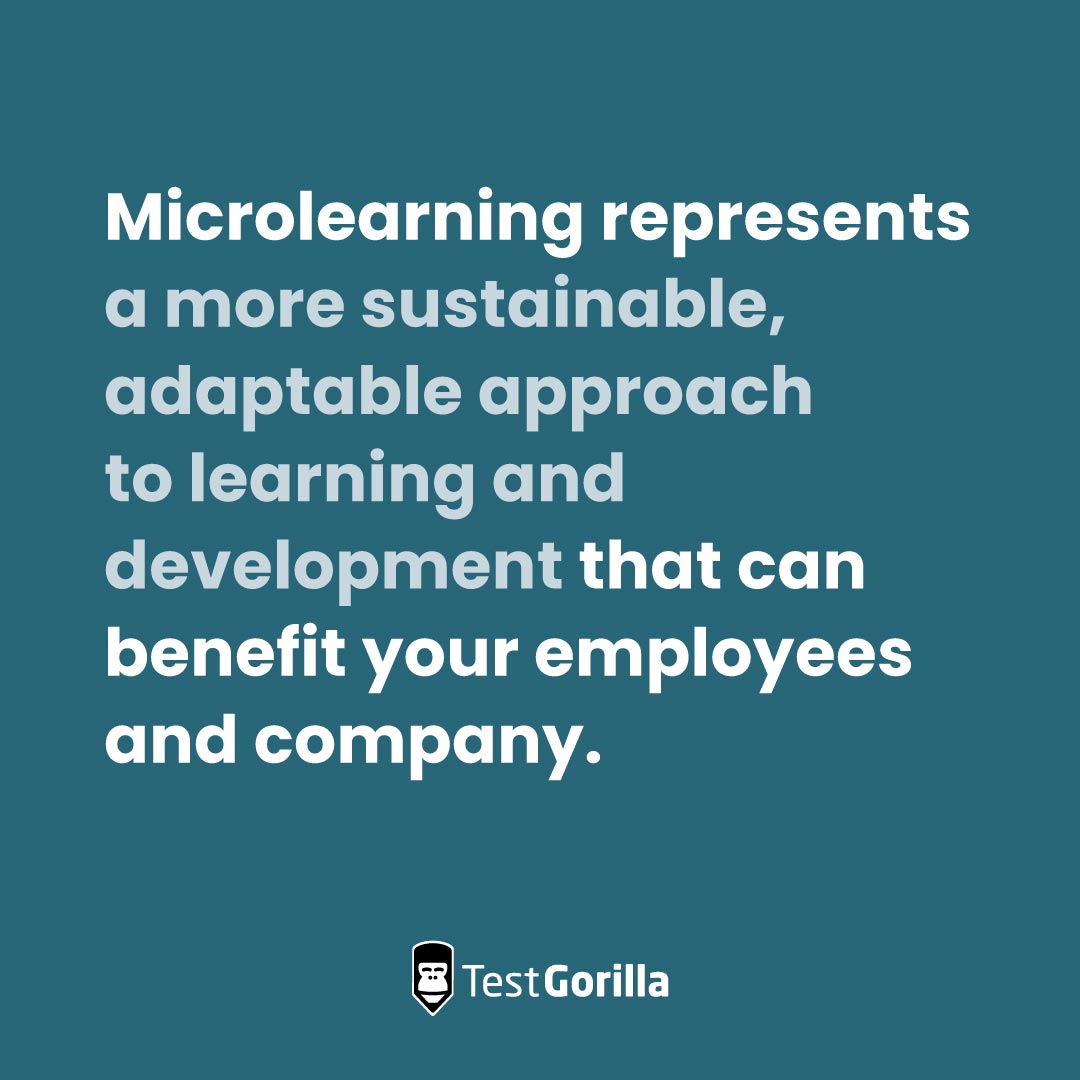Microlearning, macro benefits: How to make skills training more sustainable
With over half the workforce needing new skills – like digital literacy or data analysis – to do their jobs, skills training isn’t just a nice-to-have.1 You should continually upgrade and refresh your team’s knowledge and abilities if you want to stay competitive and attract top talent.
But implementing skills training that actually sticks can be a challenge when you rely on traditional training methods like seminars and workshops, as these approaches may not be the best for engaging or motivating employees.
If you have a diverse team, they’ll also have a mixture of unique learning styles and preferences. Traditional training methods that rely on written content or long sessions in particular can be an endurance test for the neurodiverse, among others.
Both individuals with ASD (autism spectrum disorder) and ADHD (attention-deficit/hyperactivity disorder) suffer from working memory impairments, so having to sit through a day-long training may not be the best way to help them learn.2
Microlearning represents a more sustainable, adaptable approach to learning and development that can benefit your employees and company.
Let’s explore five reasons why you should make microlearning part of your skills training approach, and how to implement it in your organization.
Table of contents
What is microlearning?
With microlearning, the secret is in the length and delivery method, not the content format.
Kalina Trajanoska, co-founder and chief executive officer of the microlearning startup Coach, defines microlearning as “bite-sized learning. Traditional training is often long-format learning, while microlearning is a term we use for short-term learning that can be completed in three to five minutes.”
Microlearning content can be a three-minute video, a bite-sized lesson to brush up on knowledge, or a few paragraphs of text that employees receive via email or push notification. The key is that it should take less than five minutes to complete.
5 macro benefits of microlearning
Before founding Coach, Kalina helped a high-end car company digitize their sales training. The company would run seminars each time the latest car model came out to train their salespeople on the new design and features.
Kalina noticed that, just a couple of weeks after the seminar, salespeople would forget everything they had learned and the sales process would suffer as a result. After seeing this pattern with traditional training in numerous large companies, she came across a solution: microlearning.
Microlearning improves training output and efficiency and makes the learning experience more accessible, flexible, and engaging for employees.
Let’s take a look at those benefits in more detail.
1. Makes training more accessible
Each of your employees has unique needs, learning styles, and personal circumstances, so a one-size-fits-all traditional learning approach doesn’t always yield great results. Here are a few reasons why microlearning is more accessible:
It suits those who are short on time or have difficulty concentrating. Microlearning is more accessible, for example, for neurodiverse team members who may have trouble staying focused during a day- or even hour-long seminar. It’s also better for employees who work part-time as part of a job share. This is because smaller chunks of learning fit much better into a part-time schedule than a two-hour training call.
It lets you use different delivery methods. This could be a video sent via email or a quick lesson that shows up as a push notification on an app. You can also customize lessons to fit different learning styles, from visual and auditory to reading and writing.
It’s a good fit for employees of all ages. Microlearning can be adapted to Gen Z team members who prefer to receive information in bite-sized portions, millennials who learn well through gamification, and Boomers who want an accessible way to improve their digital skills. For example, you could use microlearning to deliver training on Microsoft Excel to employees across all these age groups, making the content concise for Gen Z employees, engaging for millennials, and user-friendly for Boomers.
2. Provides a more agile, efficient learning experience
Because microlearning allows employees to learn on their own time, it’s less rigid than traditional training methods and, therefore, likely to see greater participation. Here’s why:
It’s flexible enough to allow quick adaptation to new trends. For example, you don’t have to carve out half a day to organize and run a training seminar to get your developers up to speed on how to use the latest AI tool for coding. Instead, you can share microlearning tasks for employees to complete when it best suits them throughout their workday. This keeps them updated and their knowledge fresh without spending hours in a training session.
Microlearning apps adapt the learning experience to fill user knowledge gaps. Tools like Coach learn from the mistakes a user makes during their training sessions to reinforce and quiz them on that information afterward.
It’s a big time saver for companies and employees. As mentioned, you don’t have to block numerous hours every month to run training sessions. Instead, your people can take a few minutes each day to learn new skills and brush up on knowledge.
3. Engages your employees better than traditional learning
We shift our attention after about 47 seconds, so it’s no surprise people have a hard time focusing with long-form training content. Microlearning is quick and agile, which makes it better to engage people than a long training session. Here are a couple of reasons why:
It can consist of learning games or short videos. These add a gamification element to the learning process that keeps employees interested.
Allows for incorporation of positive feedback or points systems. This helps get employees motivated and engaged with training, which can boost employee satisfaction and help you retain and reward talent.
Because it’s more engaging, employees express higher levels of satisfaction with microlearning. This may lead to increased knowledge retention, which leads us into our next point.
4. Improves knowledge retention
Kalina emphasizes that microlearning helps with information retention because “when broken down into digestible pieces of information, complex concepts or large amounts of information are easier to remember.”
No matter how well something is taught, we can’t remember it forever. The forgetting curve is a memory model formulated by German psychologist Hermann Ebbinghaus in the 19th century. It demonstrates the decline of memory retention over time when no attempt is made to retain information.
Microlearning can help negate the forgetting curve. This learning method can improve knowledge and skills retention, making it a great tool for reinforcing and reintroducing information. Even if you have to run a company-wide seminar or long-form training session, you can implement microlearning to ensure employees retain that information over time.
5. Helps your company and employees stay competitive
Microlearning comes in short, accessible formats. This means it’s easy to integrate into your employees’ workdays, so you can continually be training your people. Here’s how:
It allows you to quickly bring employees up to speed. With microlearning, you don’t have to block out an afternoon on everyone’s calendar to update them on the most relevant skills or new developments. This means you can constantly be filling knowledge gaps, which helps you stay ahead of the curve.
Microlearning lets employees upskill and reskill on their own terms. This is critical to professional growth and more motivating than top-down initiatives that take them away from their work for long periods of time. While your company can benefit from implementing microlearning, it’s also important to demonstrate to your employees that microlearning can give them the boost they need to move up in their careers.
The best insights on HR and recruitment, delivered to your inbox.
Biweekly updates. No spam. Unsubscribe any time.
5 steps to implement microlearning in your organization
If you’re sold on using microlearning to upskill your team, you need to learn how to implement it to ensure its success.
1. Identify skills gaps
No matter how well you think you know your business and your people, nothing beats hard data.
Before getting started with microlearning, perform a skills gap analysis to figure out where your employees need the most support.
Talent assessments let you assign targeted tests to check competencies among your people and pinpoint the knowledge gaps you need to fill. You can test for specific skills, like CSS development or technical SEO, as well as your employees’ abilities to properly use the tools that help them do their job, like Salesforce or Google Analytics.
You can even test for skills gaps in less technical areas that are still critical for your business, like business ethics, understanding instructions, or time management. Be sure to also ask your employees where they feel their skills gaps lie so you can best target training materials to fit their learning and development goals.
2. Determine the appropriate learning format for each skill or area of knowledge
While a video might cover everything you need to say about business ethics, filling in skills gaps related to a complex programming language will require more interactive training. That’s why it’s important to pick the appropriate format to teach each skill.
Microlearning gives you the ability to present content in many different formats. This means you can adapt it to just about any type of learning material.
Say you have to teach something in a long-form training session, like an in-depth webinar about following privacy laws and maintaining GDPR compliance. You can use short microlearning videos to help employees retain and brush up on that information over time.
3. Build out a microlearning system
If all your training materials currently exist as traditional long-form content, you need to know how to get started moving toward a microlearing approach.
Start by building out a system and use a specialized tool to help you.
First, design a plan to set expectations for how frequently employees should complete training activities and how long it should take them to reach training benchmarks. This will ensure your strategy is well-organized and give you a targeted approach to reskill and upskill employees.
Additionally, use a specialized app or platform like Coach to help you transform your long-form training content into microlearning content. These tools can help you remodel your existing training materials and package the content appropriately. For example, by creating a push notification to complete a quiz or an email with a detailed infographic.
4. Communicate the benefit to employees
It benefits employees to engage with microlearning initiatives, which offer an accessible, flexible way to level up in their skills and work toward the next promotion or step in their career. However, unless you explain the benefits, they may see microlearning as just another box to be checked.
To get them on board, show them the benefits of microlearning for their career and professional development.
Frame microlearning as an accessible, easy-to-complete shortcut for employees to shrink knowledge gaps, learn new skills, and get on a steady upward path of career growth. It’s also potentially more enjoyable and engaging than the traditional learning methods they might have to take part in otherwise.
5. Analyze your approach and measure results
Like any new process, you should test the results of microlearning to figure out what’s working and where you can improve.
Set key performance indicators like completion rates, time to completion, and employee satisfaction, and track these metrics over time.
Tracking those metrics alone won’t tell you whether microlearning is actually working, however. Even if employees are completing the tasks they’re assigned and generally enjoy the new format, you need to evaluate whether it’s filling knowledge gaps and helping them retain information.
Use talent assessments to measure skills gained and see whether employees have actually improved through microlearning. Then, iterate and repeat.
Microlearning: Make learning more accessible for diverse teams
To help your employees progress in their careers while keeping your business competitive, you should provide continual learning opportunities.
Unique learning styles, plus varying ages, backgrounds, and neurodiverse profiles, mean traditional training methods may fall short when it comes to narrowing knowledge and skills gaps on diverse teams. Microlearning represents a solution to transform long-form training materials into engaging, interactive content employees will be more engaged with.
When properly implemented, this training approach allows your employees to gain and update the skills and knowledge they need to stay competitive and do their jobs. To do this, use talent assessments to identify skills gaps. Then, create a system to convert long-form content to microlearning. Communicate the benefits to employees to get them on board, try it out, measure success, and iterate.
When you successfully implement microlearning in your organization, it can help you attract, retain, and reward talent; fill roles internally through upskilling and reskilling; and boost your ROI on hiring. All of this ensures your company and people stay competitive and ahead of the curve.
Make skills gaps a thing of the past. Talent assessments let you keep your people updated on key skills. Download the 2022 State of Skills-Based Hiring Report to learn more
Sources
1 “Gartner HR Research Finds 58% of the Workforce Will Need New Skill Sets to Do Their Jobs Successfully.” Gartner (2021) Retrieved on May 19th, 2023 https://www.gartner.com/en/newsroom/press-releases/2021-02-03-gartner-hr-research-finds-fifty-eight-percent-of-the-workforce-will-need-new-skill-sets-to-do-their-jobs-successfully
2 A Meta-Analysis of Working Memory Impairments in Autism Spectrum Disorders, 2017; Working memory and short-term memory deficits in ADHD: A bifactor modeling approach, 2020
You've scrolled this far
Why not try TestGorilla for free, and see what happens when you put skills first.

















